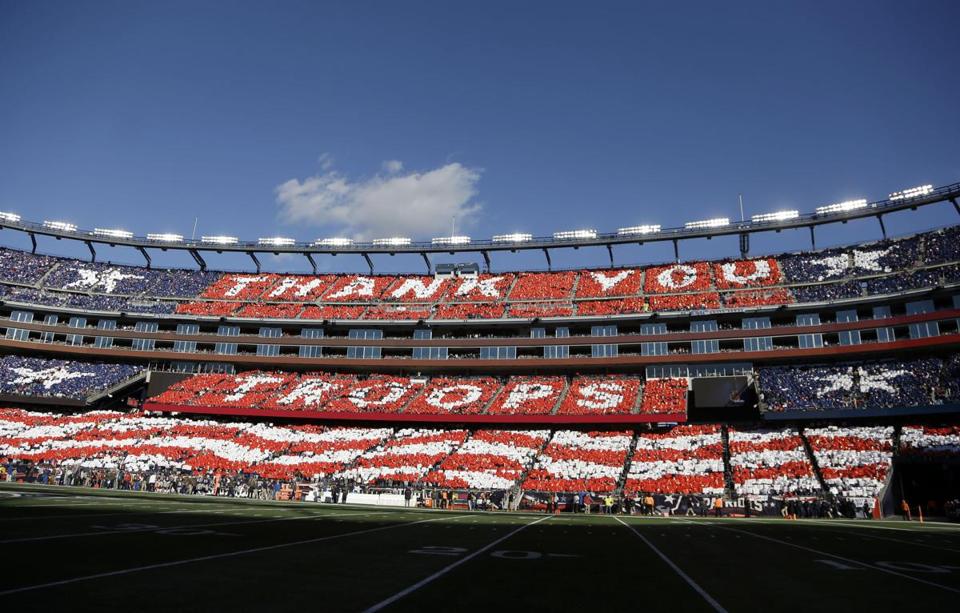The Best Health Care System in the US (And Its Biggest Secret)
When it comes to supporting our troops, the gold standard is the VA. Veteran’s Affairs runs the largest health system in America with 1,700 hospitals, clinics and other health care facilities. It also happens to be the only real single payer health system run by the federal government. A pretty busy place, the VA is the port of call for hundreds of thousands of Afghanistan and Iraq veterans with major wounds in mind and body. 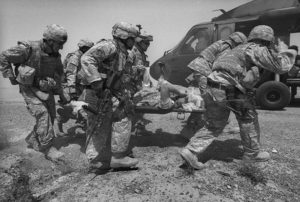 Considering that 2.5 million veterans fought in Iraq or Afghanistan (many in both) during the 15 years and counting that we have been at war in one or both of these two countries and that advances in battlefield medicine have kept alive many thousands of horribly wounded soldiers, the VA might be the busiest health care facility on earth. Not to mention the entry of thousands of Vietnam veterans whose health care needs are skyrocketing as they enter their “golden” years.
Considering that 2.5 million veterans fought in Iraq or Afghanistan (many in both) during the 15 years and counting that we have been at war in one or both of these two countries and that advances in battlefield medicine have kept alive many thousands of horribly wounded soldiers, the VA might be the busiest health care facility on earth. Not to mention the entry of thousands of Vietnam veterans whose health care needs are skyrocketing as they enter their “golden” years.
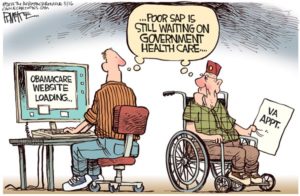
Have you read the Introduction to “The Best Health Care System in the US”?
Insufficient Funds in America’s Health Care Account
With a full to overflowing dinner plate like that and our professed reverence for our “wounded warriors,” the VA must surely be the largest government agency in terms of the allocation of funds. Right? Not even second, third, or fourth, but fifth in spending. At $163 billion budgeted for FY 2016, the VA is outspent by the Department of Defense at $573 billion, a figure that does not include the classified portions of the DOD budget which most experts estimate brings the total defense budget well over $1 trillion.
Unlike Medicare, the Veteran’s Affairs is truly a single payer health care system. Veterans do not have to obtain private insurance to get full coverage. The biggest benefit, however, [drum roll please] is one few people know about —the VA can negotiate drug prices with the drug companies and medical device makers.
Can Medicare negotiate prices with the drug companies? No and escalating drug and deice prices are the result. US per capita health care spending rings in at more than twice the average of other developed countries with similar economies. Think of it — if current US health care costs were spread out over the entire population, it would cost every man, woman, and child in America $9,024.
 The Affordable Care Act (AKA Obamacare) hailed by President Obama as his signature achievement is basically a major-league dud. Whether it’s better than nothing is debatable. Not only does it fail to include cost control measures (by design), the system has serious flaws in design (by design as well). Obama, succumbing to the dictates of his heavy hitter health industry donors (in the 2008 election, the health industry ponied up $22 million; in 2012, $19 million) hunkered down on the provision, passed as part of the legislation creating Medicare Part D in 2003 which gave senior s insurance coverage for drugs but forbade Medicare from negotiating for lower drug prices. As we speak, Medicare pays on average 85% of the official price of brand name drugs — the VA 45%. Not to mention price inflation on old and new drugs. Even generics are getting the message —it’s the Wild West out in free market land. As the largest purchaser of drugs in the US, Medicare could have begun a landslide of falling prices that would have had a ripple effect on the entire health care system. How big are the stakes? From 1998 to 2008, the amount Americans spent on prescription drugs more than doubled to $234 billion – a number that increased to $374 billion in 2014, increased a stunning 12.2% to $425 billion in 2015. How do they get away with it? Bernie Sanders knows: “Since 1998, the pharmaceutical industry has spent over $900 million on lobbying activities; That is more than any other industry in the United States of America.”
The Affordable Care Act (AKA Obamacare) hailed by President Obama as his signature achievement is basically a major-league dud. Whether it’s better than nothing is debatable. Not only does it fail to include cost control measures (by design), the system has serious flaws in design (by design as well). Obama, succumbing to the dictates of his heavy hitter health industry donors (in the 2008 election, the health industry ponied up $22 million; in 2012, $19 million) hunkered down on the provision, passed as part of the legislation creating Medicare Part D in 2003 which gave senior s insurance coverage for drugs but forbade Medicare from negotiating for lower drug prices. As we speak, Medicare pays on average 85% of the official price of brand name drugs — the VA 45%. Not to mention price inflation on old and new drugs. Even generics are getting the message —it’s the Wild West out in free market land. As the largest purchaser of drugs in the US, Medicare could have begun a landslide of falling prices that would have had a ripple effect on the entire health care system. How big are the stakes? From 1998 to 2008, the amount Americans spent on prescription drugs more than doubled to $234 billion – a number that increased to $374 billion in 2014, increased a stunning 12.2% to $425 billion in 2015. How do they get away with it? Bernie Sanders knows: “Since 1998, the pharmaceutical industry has spent over $900 million on lobbying activities; That is more than any other industry in the United States of America.”
Any bets on how badly big Pharma wants to shut the VA down and end this “nonsense” about lowering drug prices? How better to do that than force privatization. 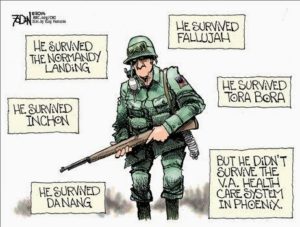 The window to privatize the VA opens a little wider every time this overcrowded and underfunded agency stubs its toe as it did in 2014 when reports circulated of substandard and delayed care at a facility in Phoenix, Arizona, possibly resulting in up to 40 veterans’ deaths.
The window to privatize the VA opens a little wider every time this overcrowded and underfunded agency stubs its toe as it did in 2014 when reports circulated of substandard and delayed care at a facility in Phoenix, Arizona, possibly resulting in up to 40 veterans’ deaths. 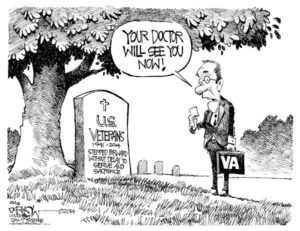 The resulting bad publicity had a multiplier effect prompting new calls for a privatized system. The wall was breached when congress, sensing a golden opportunity, quckly passed a law giving veterans in remote areas the option of seeking private care. From small acorns, big oaks grow. The next step may well be a fully privatized system of veterans’ care with the free market determining who will get what care. It’s a system fraught with overpriced fee-for service-practitioners, expensive diagnostic testing and unchecked drug costs promising a rocky road for our “wounded warriors.”
The resulting bad publicity had a multiplier effect prompting new calls for a privatized system. The wall was breached when congress, sensing a golden opportunity, quckly passed a law giving veterans in remote areas the option of seeking private care. From small acorns, big oaks grow. The next step may well be a fully privatized system of veterans’ care with the free market determining who will get what care. It’s a system fraught with overpriced fee-for service-practitioners, expensive diagnostic testing and unchecked drug costs promising a rocky road for our “wounded warriors.”
No sentient being can deny that a system as large and sprawling as the VA does not have a few bad apples like the facility that kept two sets of books to hide the lengthy waiting times for care. Another thorny issue— the backlog of claims for disability payments. Here’s President Obama in a 2008 campaign speech decrying the 400,000 veterans waiting for decisions on their disability claims during the Bush years: “When a veteran is denied healthcare, we are all dishonored…When 400,000 veterans are stuck on a waiting list for claims, we need a new sense of urgency…As president, I won’t stand for hundreds of thousands of veterans waiting for benefits. In the first year of Obama’s presidency, 600,000 veterans had disability claims pending – some for more than three years. Despite President Obama and Congress promising to eliminate the backlog by the end of 2015, in July, 2016, unresolved disability claims topped 70,000. More disturbing still, twenty percent of veterans wait more than four months to have their claims investigated. Critically wounded veterans whose only sin was fighting the often inane and always brutal wars the US starts all over the planet deserve a whole lot better. Absentmindedly thanking them for their service is a poor replacement for healing the wounds of their minds and bodies
Is this the best the US government can do? Since 2000, the VA budget has tripled yet failed to keep up with the staggering toll of military carnage in the thirteen years the US has been at war – the longest period of continuous war in American history.
Presidents Call for Peace and Promote War
The best and most obvious solution to this over-burdened system is to stop waging war and embrace the peace our leaders keep telling us is in our DNA.
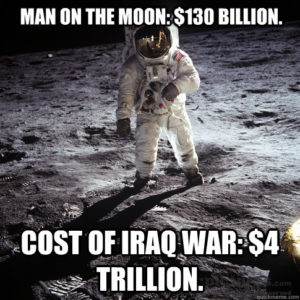
I am talking about genuine peace, the kind of peace that makes life on earth worth living, the kind that enables men and nations to grow and to hope and to build a better life for their children—not merely peace for Americans but peace for all men and women—not merely peace in our time but peace for all time. —John F. Kennedy [Commencement Address at American University, June 10, 1963, having already raised the number of US “advisors” in South Vietnam from 700 in 1962 to 15,000 in 1963.
We hope that peace will come swiftly. But that is in the hands of others beside ourselves… [U]ntil that bright and necessary day of peace we will try to keep conflict from spreading. We have no desire to see thousands die in battle–Asians or Americans. We have no desire to devastate that which the people of North Viet-Nam have built with toil and sacrifice. We will use our power with restraint and with all the wisdom that we can command. — Lyndon B. Johnson [Address at Johns Hopkins University, April 7, 1965. 58,000 Americans ultimately died in the Vietnam War along with millions of Vietnamese, thousands of Laotians and Cambodians. The carnage in North and South Vietnam was replicated in Laos and Cambodia]
 The service and sacrifice of our men and women in uniform has promoted peace and democracy…We have borne this burden, not because we seek to impose our will…[but] out of enlightened self-interest…Yes, the instruments of war do have a role to play in preserving the peace…America has never fought a war against democracy and our closest friends are governments that protect the rights of their citizens…[W]e can understand that there will be war and still strive for peace. —Barack Obama [accepting the 2009 Nobel Peace Prize on December 9, 2009. Eight days earlier he had announced the deployment of 30,000 additional troops to Afghanistan bringing the total number of Americans in Afghanistan to more than 100,000; at the same time he gave expanded authority to the CIA for unmanned drone attacks in Pakistan and Afghanistan]
The service and sacrifice of our men and women in uniform has promoted peace and democracy…We have borne this burden, not because we seek to impose our will…[but] out of enlightened self-interest…Yes, the instruments of war do have a role to play in preserving the peace…America has never fought a war against democracy and our closest friends are governments that protect the rights of their citizens…[W]e can understand that there will be war and still strive for peace. —Barack Obama [accepting the 2009 Nobel Peace Prize on December 9, 2009. Eight days earlier he had announced the deployment of 30,000 additional troops to Afghanistan bringing the total number of Americans in Afghanistan to more than 100,000; at the same time he gave expanded authority to the CIA for unmanned drone attacks in Pakistan and Afghanistan]
Podium Platitudes Do Not End War
Ending war for real would be a giant step toward stopping the procession of future generations of broken and damaged young people crowding the hopelessly inadequate facilities that are supposed to minister to their needs. Given eight years of White House posturing, not to mention the sixty plus years of pious peace declarations preceding it, replacing war with diplomacy, red lines and collusion with negotiations (“We came, we saw, he died.” Secretary of State Clinton on America’s collusion in the murder of Muammar Gaddafi), seem the impossible dream indeed.
“I will only send you into harm’s way when it is absolutely necessary, and with the strategy, the well-defined goals, the equipment and the support that you need to get the job done…” —2009 Barack Obama commencement address at the Naval Academy
“The United States will use military force, unilaterally if necessary, when our core interests demand it: when our people are threatened; when our livelihoods are at stake; when the security of our allies is in danger… I believe in American exceptionalism with every fiber of my being.” —2014 Barack Obama commencement address at West Point.
We Have a Job to Do
As our leaders dither, America is creating more and more “wounded warriors” —young men and women fighting the wars engineered by well-connected elites always on the hunt for another pile of gold to add to their stash. Striving for model care centers at every VA facility, doling out effective and timely care to all veterans who need it —worthy goals within our reach, but not solutions. In the past year, $95.3 billion of the VA budget covered mostly disability payments to veterans wounded in all the wars the empire has and is continuing to fight. $70.3 billion was spent on actual health care services. It’s time for congress and the new president to stop pretending that “mismanagment” at the VA is the source of the problem. We know better. Putting the brakes on war, stopping the insane race to upgrade our nuclear weapons stockpile, to develop new and more destructive weapons of death —that’s where the rubber hits the road.
If we fail, then our failure will be most keenly felt in the households of wounded veterans and their families. Our over-burdened VA will succumb to the pressure for privatization from the wealthy elite and their water carriers in congress and the white house. Our veterans will be left holding the bag. In a privatized system, time delays will not be the major hurdle veterans and their families must overcome. As the cost of medical care increases, many veterans will be left out in the cold. War does more than lead to overcrowded facilities. From 2001 to 2014, as the civilian suicide rate rose about 23.3 percent, the rate of suicide among veterans jumped more than 32 percent. Isn’t it overtime to make sure the ugliness and brutality of war don’t consign more of America’s young to that awful fate?
Why We Must Not Fail
It’s over time to say “enough.” Enough with the imperialism and militarism that have characterized the decisions of post World War II American foreign policy makers from George Kennan to John Kerry. Enough with the cries of American exceptionalism to justify yet another incursion into someone else’s country. Enough with the hypocrisy that has cloaked naked aggression in the flowing robes of “responsibility 2 protect” and “humanitarian intervention, the anti-Communist rhetoric that has hidden America’s aversion to populist or nationalist movements in 20 developing countries all over the world and the paeans to freedom and democracy that have disguised plots to: overthrow more than 50 foreign governments, assassinate more than 50 leaders; and drop bombs on the people of more than 30 countries.[1] It’s time for the US to remember the promise every president has made to our veterans and then broken —This nation has a solemn obligation to take care of its veterans and to honor them for their service and sacrifice on behalf of the United States.” [Barack Obama, 2015] It’s time to give teeth to that solemn obligation. Stop war, stop financing military contractors, stop training and equipping despots and oligarchs with the weapons to lay waste their countries and devastate their people. Stop the endless global war on terror. The US accounts for a larger share of global military spending {37%) than of population (4%) or of GDP (22%). Think how much of the VA’s current deficiencies will be cured with an infusion of war dollars that will no longer be needed by a peace-loving America.
 With war in the rear-view mirror, we can help today’s young victims of America’s war on the world heal. After that, it’s a short leap to another sorely needed government run health care system – Universal Health Care for all Americans.
With war in the rear-view mirror, we can help today’s young victims of America’s war on the world heal. After that, it’s a short leap to another sorely needed government run health care system – Universal Health Care for all Americans.
 O, let America be America again–
O, let America be America again–
The land that never has been yet–
And yet must be–the land where every man is free.
The land that’s mine–the poor man’s, Indian’s, Negro’s, ME–
Who made America,
Whose sweat and blood, whose faith and pain,
Whose hand at the foundry, whose plow in the rain,
Must bring back our mighty dream again.
Langston Hughes “Let America Be America Again”
[1] William Blum, America’s Deadliest Export: Democracy–the Truth about US Foreign Policy and Everything Else (Fernwood Publishing, Halifax, 2013), p. 1.
1,212 total views, 1 views today
